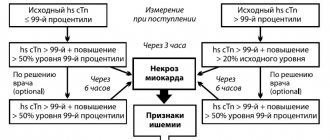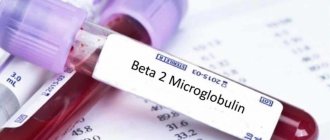Impaired glucose tolerance, or prediabetes, is a condition that involves elevated blood sugar levels, but the levels are not as high as in the case of overt type 2 diabetes. Moreover, this condition is borderline, therefore, without appropriate intervention from both the specialist and the patient, it can develop directly into diabetes, as well as cause other serious complications. With the right influence it can be corrected.
Medical diagnostic is a clinic that provides services for the treatment of many diseases, including the endocrine system. A thorough diagnosis allows you to develop an individual treatment regimen and correct the patient’s condition, thereby avoiding the serious consequences of a pre-diabetic condition.
Sugar curve - test for glucose tolerance.
The glucose tolerance test (sugar curve) is a simple but very valuable test, indispensable for assessing carbohydrate metabolism, i.e.
to detect diabetes and prediabetes. The test is carried out as follows. The patient comes to the laboratory in the morning on an empty stomach, after 8-14 hours of fasting, and takes a blood test for sugar (glucose). The analysis must be done immediately. If fasting blood sugar does not exceed 7.0 mmol/l, then the patient drinks a glass of water in which 75 grams of glucose is dissolved. This is a standard, fixed amount of carbohydrates for which standards have been developed. You cannot replace glucose with granulated sugar or another sweet drink. You can add a little lemon juice to the glucose solution for a more pleasant taste.
2 hours after taking glucose, the patient donates blood again for sugar. In the case of pregnant women, blood is donated after 1 hour and after 2 hours. The patient must sit and not walk or lie down during the entire examination. You should also refrain from smoking before and during the test.
Sugar curve - glucose tolerance test
A blood test for glucose must be carried out in the laboratory using special devices - analyzers with high accuracy. Glucometers cannot be used to carry out the test, as their error of change is too great.
What does a blood sugar test show?
The analysis shows the level of sugar (glucose) in the blood, which may indicate the presence of diabetes mellitus and other diseases.
Low sugar levels (hypoglycemia) can signal diseases of the pancreas, liver, kidneys and adrenal glands, as well as the hypothalamus.
The most common cause of high blood sugar (hyperglycemia) is diabetes. Hyperglycemia can also indicate other endocrine diseases, problems of the liver and hypothalamus, and a constant inflammatory process in the body.
There is also a glucose tolerance test (also known as a glucose tolerance test or GTT), which is performed to detect prediabetes and is also prescribed to pregnant women.
How to evaluate the results of the sugar curve?
In a healthy person, blood sugar from a vein on an empty stomach is no higher than 6.1 mmol/l, and 2 hours after a meal or glucose load is 7.8 mmol/l.
If fasting sugar is 7.0 mmol/l and higher, or after 2 hours is higher than 11.0 mmol/l, then diabetes mellitus is diagnosed. If the sugar levels are between normal and diabetic, then this is prediabetes (the diagnosis will sound like impaired glucose tolerance or impaired fasting glycemia).
For pregnant women, the norms are different - on an empty stomach less than 5.1 mmol/l, after 1 hour no higher than 10.0 mmol/l, after 2 hours no higher than 8.5 mmol/l. If blood sugar is higher than normal in at least one measurement, diabetes is diagnosed.
Prediabetic condition: causes
The main causes of impaired glucose tolerance are the following:
- significant excess weight, in the development of which the main factors are transmission and a sedentary lifestyle;
- genetic predisposition: it has been proven that family members where someone had or is suffering from diabetes are also at risk, which made it possible to identify certain genes responsible for the production of complete insulin, the sensitivity of peripheral tissue receptors to insulin and other factors;
- age and gender: most often prediabetes and diabetes are diagnosed in women over 45 years of age;
- other diseases: we are talking primarily about diseases of the endocrine system, leading to hormonal imbalance and metabolic failure, as well as diseases of the gastrointestinal tract (stomach ulcers, due to which the process of glucose absorption can be disrupted) and diseases of the cardiovascular system (atherosclerosis, high blood pressure, high cholesterol, etc.). For women, polycystic ovary syndrome may be a risk factor;
- complicated pregnancy: often prediabetes, which turns into type 2 diabetes, also occurs after gestational diabetes, which appears in women during pregnancy. Typically, problems with blood sugar levels occur in late pregnancy or large fetal sizes.
It should also be remembered that prediabetic condition can be diagnosed not only in adults, but also in children. Prediabetes in a child usually occurs as a consequence of an infectious disease, or, less commonly, of surgical intervention, which makes it necessary to pay special attention to the period of rehabilitation of the child after illness or surgery.
Prediabetic state: complications
The main complication of this condition is, of course, its possible transition to acquired type 2 diabetes, which is much more difficult to keep under control. In addition, the presence of excess sugar in the blood, even if not at a critical level, leads to an increase in blood density, which can cause the formation of plaques, blockage of blood vessels and, as a result, problems with the cardiovascular system, namely heart attacks and strokes.
In turn, the transition of the prediabetic state to diabetes entails possible damage to other body systems, including the kidneys, vision, nervous system, decreased immunity and general body resistance.
Glucose tolerance test (extended)
The oral glucose tolerance test (extended) consists of determining the level of plasma glucose on an empty stomach and every 30 minutes (30, 60, 90, 120 minutes) after a carbohydrate load in order to diagnose various disorders of carbohydrate metabolism (diabetes mellitus, impaired glucose tolerance, fasting glycemia) .
The research results are provided with a free doctor’s commentary.
Synonyms Russian
Oral glucose tolerance test (OGTT), a test for glucose tolerance, a test with 75 grams of glucose.
English synonyms
Glucose tolerance test (GTT), oral glucose tolerance test (OGTT).
Research method
Enzymatic UV method (hexokinase).
Units
mmol/l (millimoles per liter).
What biomaterial can be used for research?
Venous blood.
How to properly prepare for research?
- An oral glucose tolerance test should be performed in the morning after at least 3 days of unrestricted nutrition (more than 150 g of carbohydrates per day) and normal physical activity. The test should be preceded by an overnight fast for 8-14 hours (you can drink water).
- Your last evening meal should contain 30-50 grams of carbohydrates.
- Do not drink alcohol 10-15 hours before the test.
- Do not smoke the night before the test and until it is over.
General information about the study
An oral glucose tolerance test should be performed in the morning after at least 3 days of unrestricted nutrition (more than 150 g of carbohydrates per day) and normal physical activity. The test should be preceded by an overnight fast for 8-14 hours (you can drink water). The last evening meal should contain 30-50 g of carbohydrates. Do not smoke the night before the test and until it is over. After taking blood on an empty stomach, the subject should no more than 5 minutes. drink 75 g of anhydrous glucose or 82.5 g of glucose monohydrate dissolved in 250-300 ml of water. For children, the load is 1.75 g of anhydrous glucose (or 1.925 g of glucose monohydrate) per kg of body weight, but not more than 75 g (82.5 g); for children weighing 43 kg or more, the usual dose (75 g) is given. Smoking and vigorous physical activity are not allowed during the test. Blood is taken every 30 minutes (30, 60, 90, 120 minutes) with the determination of hyperglycemic and postglycemic coefficients.
It should be remembered that if the fasting blood glucose level exceeds 7.0 mmol/l, then the oral glucose tolerance test is not performed, since this blood glucose level itself is one of the criteria for diagnosing diabetes mellitus.
An oral glucose tolerance test allows you to diagnose various disorders of carbohydrate metabolism, such as diabetes mellitus, impaired glucose tolerance, fasting glycemia, but cannot clarify the type and causes of diabetes mellitus, and therefore, after receiving any result of an oral glucose tolerance test, it is advisable to conduct a mandatory consultation endocrinologist.
A distinctive feature of the [06-071] Glucose tolerance test (extended) from the 06-258 Glucose tolerance test (standard) is its performance not at two, but at five points (on an empty stomach and every 30 minutes: 30, 60, 90, 120 minutes) with the determination hyperglycemic and postglycemic coefficient.
What is the research used for?
For diagnostics:
- diabetes mellitus;
- impaired glucose tolerance,
- fasting glucose disorders.
When is the study scheduled?
- In case of questionable glycemic values, to clarify the state of carbohydrate metabolism;
- when examining patients with risk factors for developing diabetes mellitus: age over 45 years;
- BMI more than 25 kg/m2;
- family history of diabetes (parents or siblings with type 2 diabetes);
- habitually low physical activity;
- presence of fasting glucose or a history of impaired glucose tolerance;
- gestational diabetes mellitus or a history of birth of a fetus weighing more than 4.5 kg;
- arterial hypertension (of any etiology);
- lipid metabolism disorder (HDL level below 0.9 mmol/l and/or triglyceride level above 2.82 mmol/l);
- the presence of any disease of the cardiovascular system.
When is it appropriate to perform an oral glucose tolerance test to screen for carbohydrate metabolism disorders?
| Age of onset screening | Groups in which screening is carried out | Frequency of examination |
| > 45 years old | With normal body weight and no risk factors | If the result is normal – once every 3 years |
| Any adult | With BMI > 25 kg/m2 + 1 risk factor | If the result is normal – once every 3 years Persons with impaired glucose tolerance, fasting glycemia - once a year |
When should an oral glucose tolerance test not be performed?
- Against the background of any acute disease, including infectious.
- While taking medications that increase glycemic levels (glucocorticoids, thyroid hormones, thiazides, beta blockers, oral contraceptives). Cancellation is required (according to doctor's recommendations) 3 days before the test.
What do the results mean?
If necessary, a glucose tolerance test can be performed at 5 time points (measuring plasma glucose on an empty stomach and then every 30 minutes (at the 30th, 60th, 90th, 120th minute)), with the determination of hyperglycemic and postglycemic coefficient
Reference values
| Fasting glucose | 4.1 - 6.1 mmol/l |
| Glucose in 30 min. after glucose load | 4.1 - 7.8 mmol/l |
| Glucose after 60 min. after glucose load | 4.1 - 7.8 mmol/l |
| Glucose after 90 min. after glucose load | 4.1 - 7.8 mmol/l |
| Glucose after 120 min. after glucose load | 4.1 - 7.8 mmol/l |
Reference coefficient values
| Hyperglycemic coefficient | 1,3 — 1,5 |
| Postglycemic coefficient | 0,9 — 1,04 |
Reasons for increased blood glucose levels:
- various disorders of carbohydrate metabolism (diabetes mellitus, impaired glucose tolerance, fasting glycemia);
- false positive result - a recent or ongoing acute illness, surgery or any other stressful situation, taking medications that increase glycemic levels (glucocorticoids, thyroid hormones, thiazides, beta blockers, oral contraceptives).
Reasons for low blood plasma glucose levels:
- taking medications that reduce glycemic levels (insulin, various sugar-lowering drugs);
- insulinoma;
- excessive fasting;
- intense physical activity on the eve of the test.
What can influence the result?
- Smoking, drinking, eating, excessive physical activity during the test;
- recent acute illnesses, surgical operations or any other stressful situation.
Also recommended
What tests are advisable to take for any positive result of an oral glucose tolerance test?
1. In order to clarify the type and cause of carbohydrate metabolism disorders:
- Serum C-peptide
- Proinsulin
- Insulin
2. In order to clarify the severity of carbohydrate metabolism disorders:
- Glycated hemoglobin (HbA1c)
3. In order to identify the main complications of carbohydrate metabolism disorders:
- Albumin in urine (microalbuminuria) or Albumin-creatinine ratio (albuminuria in a single urine sample)
- Lipidogram
- Serum creatinine
- General urine analysis with microscopy
Who orders the study?
General practitioner, therapist, endocrinologist, cardiologist, nephrologist.
Literature
- Clinical recommendations “Algorithms for specialized medical care for patients with diabetes.” Edited by I.I. Dedova, M.V. Shestakova, A.Yu. Mayorova 8th edition, M., 2021.
- Definition and diagnosis of diabetes mellitus and intermediate hyperglycemia. Report of a WHO/IDF ConsultatIon. 2006.
- Recommendations for diabetes, prediabetes and cardiovascular diseases. EASD/ESC, Russian Journal of Cardiology 2014; No. 3(107):7-61.










